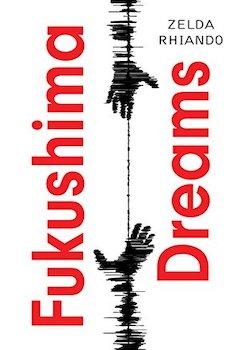Fukushima Dreams

By Zelda Rhiando
Unbound, 2018
ISBN-13: 978-1911586883
Review by Poppy Cosyns
Irish writer Zelda Rhiando follows up her self-published debut Caposcripti with this deeply unsettling novel, set in the aftermath of the 2011 triple disaster. The book came into being after it was successfully crowdfunded through Unbound, a publishing house which allows writers to pitch their work to potential backers. On hearing of the disaster at Fukushima, Rhiando became compelled to write, having had what she calls, ‘a very personal reaction to it’. She found herself trying to empathise with the 60,000 people of North-Eastern Japan, whose lives were upturned by this catastrophic event. This led to her wanting to bring the stories of those affected to an audience outside Japan, in a way that they could meaningfully connect with.
Cultural responses to the 3.11 disaster were initially few and far between, as those both inside and outside of Japan struggled to absorb and confront the enormity of such an event. As Barbara Geilhorn and Kristina Iwata-Weickgenannt write in their book Fukushima and the Arts: Negotiating Nuclear Disaster, ‘What sort of language in the wider sense could adequately express grief and trauma, and capture the profound socio-political implications of the disaster?’ The events of that day presented what they call, ‘an artistic crisis’, as a fitting reaction seemed impossible to distil into a creative project. In the period following the initial aftermath however, a huge variety of cultural responses began to emerge. Over the past few years a steady stream of filmmakers, visual artists, novelists, poets and mangaka have created works inspired by the disaster and its ongoing repercussions.
Fukushima Dreams tells the story of Sachiko and her English husband Harry, a couple who have recently relocated from Tokyo to the fictional village of Taro in Fukushima Prefecture. In the run-up to the disaster, we discover that their relationship has come under increasing strain, particularly following the birth of their son Tashi. The novel begins by plunging its reader into the midst of the earthquake and subsequent tsunami; the disorientating reality of the characters’ rapidly disintegrating surroundings described in gut-wrenching detail. There is ‘a colossal grinding and rumbling, and beneath it, the sound of human screams’ before Sachiko becomes ‘blind and breathless’ as she is ‘engulfed in cold black water’.
In the confusion of the earthquake, the family become separated from one another, as Sachiko is swept along by the mighty force of the tsunami and Harry runs into the nearby hills. The whereabouts of their small baby Tashi remains unknown. From the beginning, the narrative is divided between Sachiko’s experiences, told in the third-person and Harry’s first-person account. Rhiando’s use of these two different perspectives cleverly aids in defining each of the main characters. Sachiko – dazed and aloof – is viewed from the outside, allowing the reader to experience her as the other characters do, while self-absorbed writer Harry’s increasingly delusional state is communicated through a fevered inner-monologue.
The novel centres on the themes of collapse and estrangement. The destruction of the couple’s environment, followed by their physical separation, seeming to mirror the process of their marriage breakdown. It is the birth of their son which proves the catalyst for this process and Rhiando describes the zombie-like state of new parenthood in a way that will strike a chord with many readers. In flash-backs to the period before the earthquake, day and night merge into one, as the couple struggle to cope with their new arrival. Tashi – who appears perpetually beetroot-faced and bawling – is abstracted into something terrifying and uncontrollable, an obstacle too great for this fragile partnership to overcome. We learn that Harry and Sachiko are both out of contact with their respective families, leaving them with little in the way of a support network. When therefore, they go on to become emotionally detached from one another, they find themselves entirely isolated. This island-like state, combined with the trauma of the natural disaster combine to loosen the characters’ grips on reality and as the novel progresses it becomes increasingly dark and frequently surreal.
For the most part, Rhiando’s prose is brisk and economic but often she makes way for little passages that bring the Japan she describes to life. Given the context of the novel, there is usually an inherent poignancy to the images she conjures – the plastic sandals arranged on the porch of the makeshift rescue centre or the ‘delicately perfumed’ wagashi, bought as a gift by Sachiko, that are ‘coloured like shells’. Despite her being an outsider, Rhiando has managed to successfully convey a landscape and a society that anyone who has spent time in Japan will recognise. The strength of her research comes out in these small details and works to honour the highly sensitive subject matter of her writing. This book will be of interest to those who want to understand more about the collective trauma of an event as cataclysmic as 3.11. Above all however, this is a page-turning drama that centres on a relationship in ruins; a haunting read in every sense.

